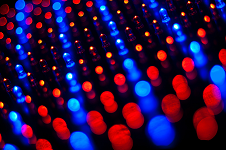Sources Overview
The Sources correspond to the light sources propagating rays in an optical system.
 |
 |
 |
The light sources are a key component of optical simulation. Speos feature allows you to model these light sources and their interaction with an optical system.
A wide variety of sources are available to cover different needs and configurations. Speos allows you to model natural light or artificial light, LED's, streetlights, indoor lighting, back lighting, displays etc.
The Sources can be used to test, adjust or validate lighting systems themselves or can be used as a tool to analyze the induced effects of light.
Types of Light Sources
- The Surface Source allows you to model the light emission of a source taking into account its flux, spectrum, exitance and intensity. The Surface Source can suit numerous configurations.
- The Ambient Sources allows you to model and generate ambient natural light in a scene (sun, sky, stars). With Ambient Sources, you can also follow CIE standards or create background setups thanks to HDR images.
- The Display Source allows you to simulate the rendering of a lit display. You can visualize the image and the luminosity of the display after simulation.
- The Luminaire Source allows you to model artificial light for indoor or outdoor lighting. This source is mainly used to simulate street lighting.
- The Ray File Source allows you to model a light source thanks to a virtual source (rayfile), created from a measured light source. The ray file, therefore, contains information like direction, power or wavelength.
- The Interactive Source allows you to link two geometries to analyze the propagation of the rays that is made through an optical system. This source is useful to understand the behavior of a light beam in a given optical system.
- The Light Field Source allows you to read the optical light field file *.olf generated by the Light Field sensor to emit light.
In Speos
You can manage all the characteristics of the light source: its power, spectrum, emission pattern etc. To create a light source you have to define several parameters: (The parameters vary based on the type of source.)
- The power of the source or flux can be defined from the interface or inherited from a file (e.g from a ray file).
- The spectrum of the light source can either be defined from the interface or downloaded from the Ansys Optical Library or created with the Spectrum Editor.
- The direction of the emission or intensity distribution can be defined from the interface thanks to standard emission patterns or inherited from an intensity distribution file that contains information about the intensity profile of the source, that is to say how the source redistributes light in space. These files can be downloaded from the Ansys Optical Library.


